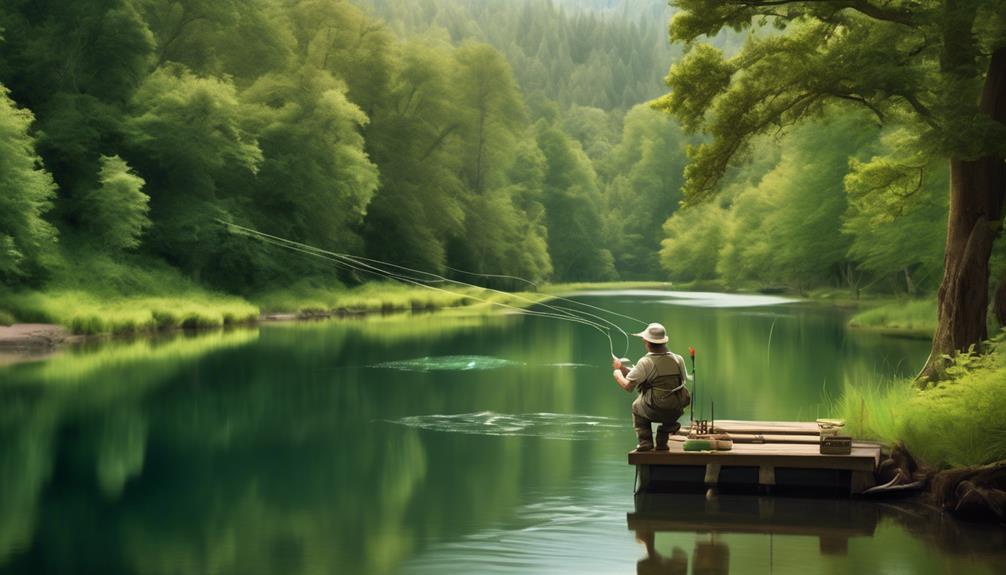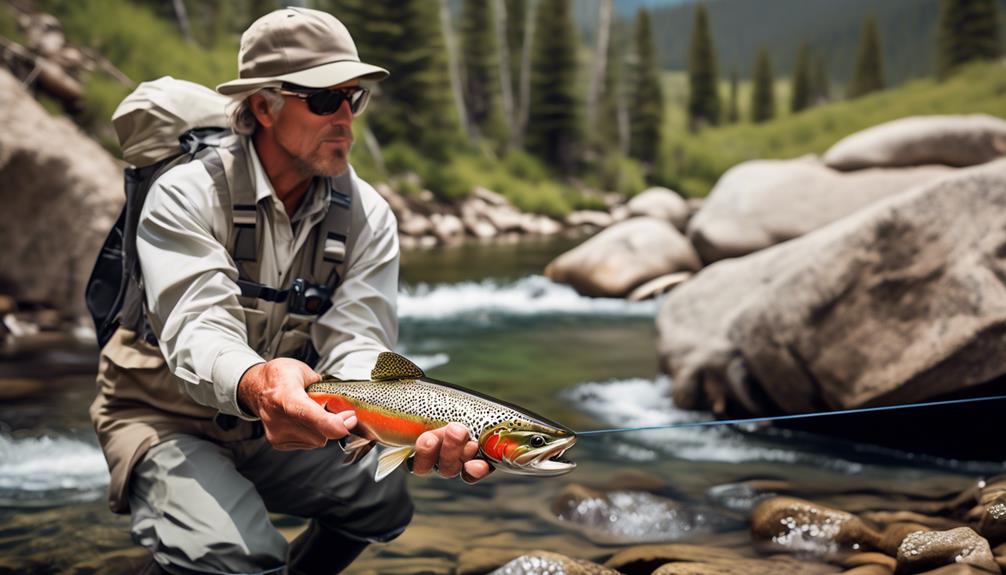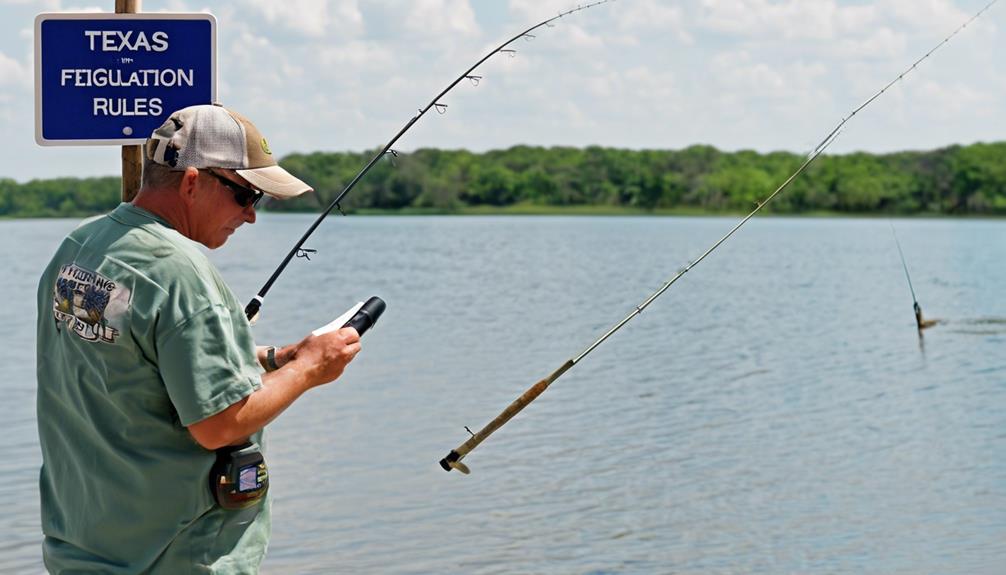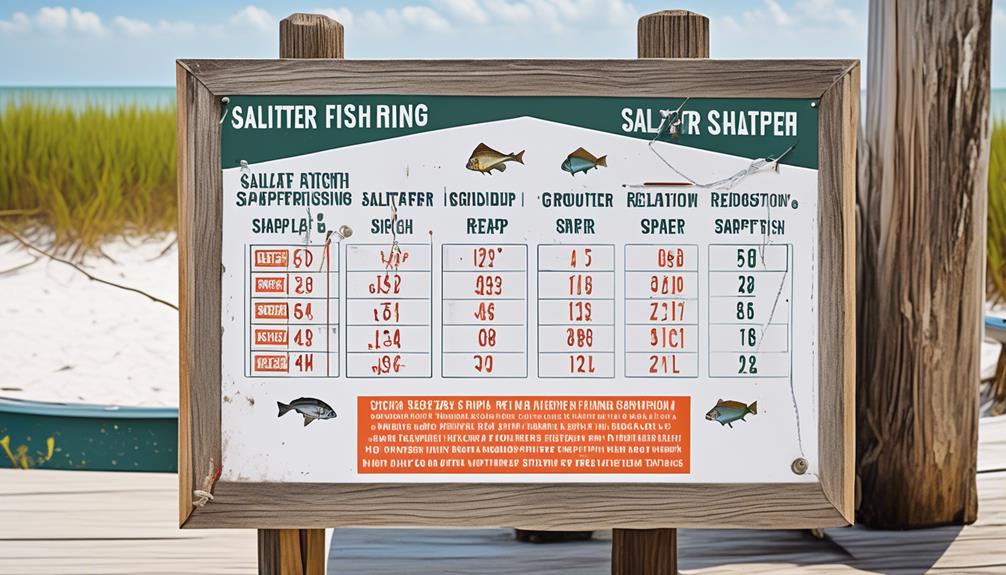As you stand at the edge of a pristine river in a national park, the allure of fly fishing beckons you. However, navigating the complex web of regulations can be a daunting task.
Understanding the nuances of fishing regulations in national parks is crucial to ensure both the protection of the natural environment and the enjoyment of this timeless pastime. The intricacies of catch and release guidelines, restricted fishing areas, seasonal regulations, and gear restrictions all play a pivotal role in preserving the delicate balance of these ecosystems.
But fear not, as mastering these regulations will open up a world of unparalleled angling experiences in some of the most breathtaking landscapes on earth.
Understanding Fly Fishing Regulations
To understand the fly fishing regulations in national parks, it's essential to carefully review the specific rules and guidelines set forth by each park's management authorities. Fly fishing techniques can vary widely depending on the park and its unique environmental considerations. Different parks may have restrictions on the types of flies, lures, or baits that can be used, as well as guidelines for catch and release practices. Understanding these regulations is crucial for preserving the natural environment and ensuring sustainable fishing practices.
When it comes to fly fishing techniques, national parks often prioritize methods that minimize environmental impact. For example, some parks may encourage the use of barbless hooks to reduce harm to fish during catch and release. Additionally, anglers are often required to pack out all their gear and any trash to maintain the pristine condition of the park's waterways. By understanding and adhering to these regulations, anglers can minimize their impact on the delicate ecosystems within national parks.
In some cases, national parks may also offer educational resources or workshops to help anglers understand the specific regulations and best practices for fly fishing within the park. These resources can provide valuable insights into the local ecosystem, endangered species, and conservation efforts, further enhancing anglers' understanding of the regulations and their role in preserving the natural beauty of national parks.
Fishing License Requirements
Before fishing in any national park, make sure to obtain the required fishing license from the park's authorities. Fishing license requirements vary between national parks, so it's essential to familiarize yourself with the specific regulations for the park you plan to visit. Permit applications for fishing licenses can usually be completed online through the park's website or in person at designated locations within the park. Be sure to provide accurate personal information and adhere to any additional requirements, such as acknowledging the park's fishing guidelines and paying any associated fees.
When it comes to age exceptions for fishing licenses in national parks, some parks may offer exemptions for children under a certain age. For example, children under the age of 16 may be permitted to fish without a license when accompanied by a licensed adult. However, it's crucial to verify the age exceptions and any accompanying regulations with the park authorities to ensure compliance. Additionally, some parks may offer discounted or free fishing licenses for senior citizens or individuals with disabilities, so be sure to inquire about these provisions if they apply to you.
Understanding the fishing license requirements and any age exceptions in the national park you plan to visit is vital for a successful and legally compliant fishing experience. By obtaining the necessary fishing license and adhering to the park's regulations, you can enjoy the natural beauty and abundant fishing opportunities that national parks have to offer.
Catch and Release Guidelines
Make sure you understand the fishing license requirements, and then you can proceed to learn about the catch and release guidelines for fishing in national parks. When practicing catch and release in national parks, it's crucial to understand the impact it has on the fish population and the environment. Catch and release guidelines are designed to minimize the impact on fish populations and their habitats, ensuring the sustainability of the ecosystem.
By releasing fish back into the water, anglers help maintain healthy fish populations. Overfishing can deplete fish populations, disrupting the balance of the ecosystem. Catch and release guidelines play a vital role in conserving fish populations by allowing them to reproduce and maintain their numbers.
In addition to preserving fish populations, catch and release guidelines also minimize the environmental impact of fishing. When done improperly, catch and release can harm fish and their habitats. Using barbless hooks, handling fish with wet hands, and minimizing air exposure are essential practices to prevent injury to the fish. These guidelines also help reduce stress on the fish, increasing their chances of survival after being released.
Understanding and following catch and release guidelines is crucial for the sustainability of fish populations and the protection of their habitats. By practicing responsible fishing techniques, anglers can contribute to the preservation of the natural environment while enjoying the sport of fishing in national parks.
Restricted Fishing Areas
Ensure that you're aware of the restricted fishing areas within the national parks before planning your fishing trip. These areas are put in place to protect the wildlife and their habitats, ensuring a sustainable and balanced ecosystem. It's crucial for you to be conscious of these restrictions to contribute to the preservation of the park's natural resources.
Wildlife protection is a top priority in national parks, and restricted fishing areas play a vital role in safeguarding the diverse species that inhabit these areas. By respecting these restrictions, you're helping to maintain the delicate balance of the ecosystem and ensuring the protection of endangered or vulnerable species.
Access limitations are often established in certain areas to prevent disturbance to nesting sites, migration routes, and sensitive habitats. These restrictions may be temporary or permanent, and they serve to minimize human impact on the environment. It's important for you to stay informed about these limitations and plan your fishing activities accordingly.
Before heading out for your fishing adventure, make sure to check the park's regulations and maps to identify the restricted fishing areas. Being mindful of these restrictions demonstrates your commitment to responsible angling and conservation efforts. By understanding and adhering to these limitations, you can enjoy your fishing experience while contributing to the preservation of the park's natural beauty and biodiversity.
Gear and Equipment Restrictions
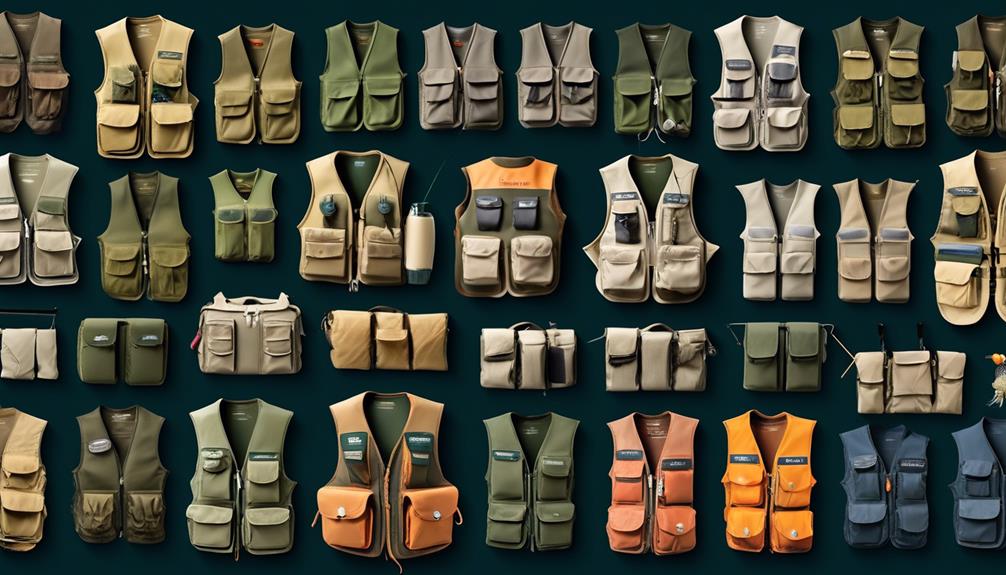
Being mindful of the importance of wildlife protection in national parks, it's essential to be aware of any gear and equipment restrictions that may be in place to ensure the preservation of the park's natural resources. When fly fishing in national parks, there are specific gear and equipment restrictions in place to protect the environment and maintain the balance of the ecosystem.
Here are the key gear and equipment restrictions to keep in mind:
- Tackle limitations and fishing zones: National parks often have specific regulations regarding the types of tackle that can be used and where fishing is permitted. It's crucial to be aware of any restrictions on the use of certain types of tackle, such as barbless hooks or artificial flies only. Additionally, some areas within the park may be designated as no-fishing zones to protect sensitive habitats or endangered species. Always familiarize yourself with the fishing zones and any tackle limitations before heading out to fish.
- Bait restrictions and equipment rules: Many national parks have regulations in place regarding the use of live bait or certain types of fishing equipment. This could include restrictions on using live bait to prevent the introduction of invasive species or limitations on the use of certain fishing equipment that could harm wildlife or the environment. It's important to thoroughly understand and adhere to any bait restrictions and equipment rules to minimize the impact on the park's ecosystem.
Seasonal Fishing Regulations
When planning your fly fishing trip in a national park, it's important to be aware of the seasonal fishing regulations that are in effect to protect the natural resources and wildlife. Fishing season limitations are put in place to ensure that fish populations have the opportunity to spawn and replenish, maintaining a healthy and sustainable ecosystem. These limitations often coincide with the breeding seasons of certain fish species, such as trout, to prevent disruption of their natural behaviors.
Understanding the environmental impact of seasonal fishing regulations is crucial for preserving the delicate balance of aquatic ecosystems. During specific times of the year, water levels may be low, and fish may be more vulnerable to overfishing. By adhering to seasonal fishing regulations, anglers can help minimize their impact on fish populations and their habitats. Additionally, certain areas within national parks may be closed off to fishing during sensitive periods to protect nesting sites for birds and other wildlife.
It's essential for anglers to stay informed about seasonal fishing regulations by checking with park authorities or accessing up-to-date resources online. Being knowledgeable about these regulations demonstrates a commitment to conservation and responsible angling practices. By respecting fishing season limitations and understanding their environmental rationale, anglers can contribute to the long-term health and sustainability of the fisheries within national parks.
Conservation and Preservation Measures
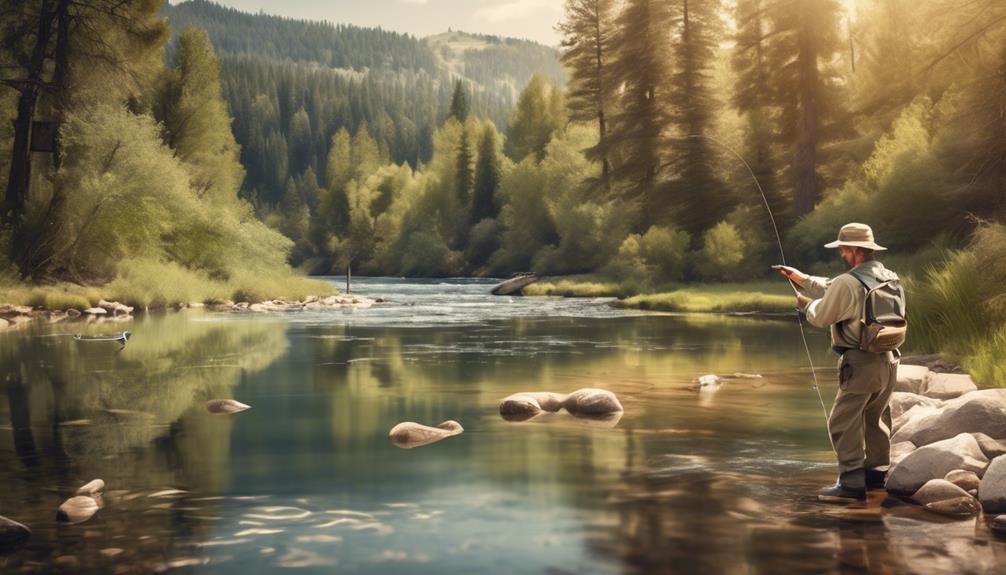
To effectively contribute to the conservation and preservation of the fisheries within national parks, stay informed about the regulations and guidelines set by park authorities. Understanding and adhering to these measures is crucial in ensuring the sustainability of the ecosystems and the enjoyment of fly fishing for generations to come.
When engaging in fly fishing within national parks, it's essential to be mindful of the following conservation and preservation measures:
- Habitat Protection: Respect the natural habitat of the fish and other wildlife by avoiding areas marked as off-limits. Be cautious not to disturb vegetation, nesting sites, or spawning grounds. By safeguarding these habitats, you can help maintain the delicate balance of the ecosystem.
- Environmental Impact: Minimize your environmental footprint by properly disposing of any waste and refraining from using lead-based fishing equipment, as it can have detrimental effects on the environment. Be conscious of your surroundings and strive to leave the environment as pristine as you found it.
- Wildlife Management and Angler Responsibility: Adhere to catch-and-release guidelines, use barbless hooks, and handle fish with care to minimize harm. Understand and follow the regulations related to the type and size of fish that can be caught, and report any observed violations to park authorities.
Compliance and Enforcement Procedures
Ensure that you familiarize yourself with the compliance and enforcement procedures established by the national park authorities to uphold fly fishing regulations and protect the delicate ecosystems. Compliance procedures are in place to ensure that all anglers adhere to the specific rules and regulations set forth by the national park. It's imperative to thoroughly understand these procedures to avoid any unintentional violations.
National park authorities employ various enforcement measures to ensure that fly fishing regulations are strictly adhered to. These measures may include regular patrols by park rangers, spot checks at fishing locations, and the use of surveillance technology to monitor angling activities. By familiarizing yourself with these enforcement measures, you can contribute to the preservation of the park's natural resources and wildlife.
In the event of non-compliance with fly fishing regulations, the national park authorities may take appropriate enforcement measures, which could include issuing fines, confiscating fishing equipment, or even revoking fishing privileges within the park. It's essential to recognize the seriousness of these enforcement actions and the potential consequences of violating the regulations.
Understanding and respecting the compliance and enforcement procedures not only ensures your adherence to the fly fishing regulations but also contributes to the overall conservation and protection of the national park's ecosystems. By actively engaging in responsible fly fishing practices and respecting the established procedures, you play a crucial role in preserving the natural beauty and ecological balance of these pristine environments.
Frequently Asked Questions
Can I Fish in National Parks Without a Fishing License if I Am Only Practicing Catch and Release?
You can't fish in national parks without a license, even for catch and release. Practice exemptions are rare and often apply to specific situations. Conservation efforts rely on regulations, so it's important to follow the rules.
Are There Any Specific Regulations for Fly Fishing in Designated Wilderness Areas Within National Parks?
In designated wilderness areas within national parks, specific regulations exist for fly fishing. You'll need special permits for catch and keep, as it can impact tourists. Always check and follow the rules to enjoy your fishing experience.
How Do I Report Violations of Fly Fishing Regulations in National Parks?
If you witness violations of fly fishing regulations in national parks, you should report them to park authorities. They can take enforcement actions to address the issue and ensure that all visitors follow the rules.
Are There Any Restrictions on the Types of Flies or Bait That Can Be Used for Fly Fishing in National Parks?
You can use a variety of fly selection for fly fishing in national parks, but there may be restrictions on bait. Some parks have exemptions for catch and release, so be sure to check the specific regulations.
Are There Any Special Regulations for Fishing in National Parks During Peak Tourist Seasons?
During peak tourist seasons in national parks, special regulations exist to protect the environment and conserve fish populations. These regulations aim to minimize the impact of fly fishing techniques on the ecosystem and ensure sustainable conservation efforts.
Conclusion
Now that you've mastered the fly fishing regulations in national parks, you can confidently enjoy this popular outdoor activity while respecting the rules and preserving the environment.
Remember to always have your fishing license, follow catch and release guidelines, and be aware of any restricted areas and seasonal regulations.
By understanding and complying with these regulations, you can ensure the sustainability of fish populations and the beauty of our national parks for future generations to enjoy.
Happy fishing!
